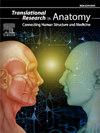列奥纳多·达·芬奇:寻找灵魂的座位——对一位伟大大师的解剖学和神经解剖学探索的反思
Q3 Medicine
引用次数: 0
摘要
文艺复兴是一个艺术、科学和哲学为追求人性真理而融合在一起的时代。列奥纳多·达·芬奇将艺术家的天赋与学者的求知欲结合在一起,超越了时代的限制,产生了卓越而创新的解剖学研究。他的观察结果——几个世纪以来没有发表,因此更广泛的受众无法接触到——在方法论和解剖学的准确性方面都明显领先于他们的时代。目的本文对列奥纳多所提出的解剖学和神经解剖学概念进行了反思,并将其置于他那个时代更广泛的知识背景中。分析的主要目的是反映随着文艺复兴的兴起而出现的知识氛围。达芬奇的研究方法在他的时代是开创性的,史无前例的。可以假设,如果他的解剖学著作在他有生之年出版,它们将对当代人类解剖学和生理学的理解产生重大影响。他的研究方法,包括解剖技术,是革命性的,超越了他那个时代知识和技术的限制。本文章由计算机程序翻译,如有差异,请以英文原文为准。
Leonardo da Vinci: In search of the seat of the soul – Reflections on the anatomical and neuroanatomical explorations of a great master
Background
The Renaissance was an era in which art, science, and philosophy converged in the pursuit of truth about human nature. Leonardo da Vinci combined the talent of an artist with the intellectual curiosity of a scholar and moved beyond the limitations of the epoch, producing anatomical studies that were exceptional and innovative. His observations—unpublished and therefore inaccessible to a wider audience for centuries—were remarkably ahead of their time, both in methodological approach and anatomical accuracy.
Aim
This paper offers reflections on selected anatomical and neuroanatomical concepts developed by Leonardo, placing them within the broader intellectual context of his epoch. The analysis aims primarily to reflect the intellectual climate that emerged with the rise of the Renaissance.
Conclusions
Leonardo da Vinci's methodological approach was groundbreaking and unprecedented for his time. It can be assumed that, had his anatomical works been published during his lifetime, they would have significantly influenced contemporary understanding of human anatomy and physiology. His research methods, including dissection techniques, were revolutionary and surpassed the limitations of the knowledge and technology of his era.
求助全文
通过发布文献求助,成功后即可免费获取论文全文。
去求助
来源期刊

Translational Research in Anatomy
Medicine-Anatomy
CiteScore
2.90
自引率
0.00%
发文量
71
审稿时长
25 days
期刊介绍:
Translational Research in Anatomy is an international peer-reviewed and open access journal that publishes high-quality original papers. Focusing on translational research, the journal aims to disseminate the knowledge that is gained in the basic science of anatomy and to apply it to the diagnosis and treatment of human pathology in order to improve individual patient well-being. Topics published in Translational Research in Anatomy include anatomy in all of its aspects, especially those that have application to other scientific disciplines including the health sciences: • gross anatomy • neuroanatomy • histology • immunohistochemistry • comparative anatomy • embryology • molecular biology • microscopic anatomy • forensics • imaging/radiology • medical education Priority will be given to studies that clearly articulate their relevance to the broader aspects of anatomy and how they can impact patient care.Strengthening the ties between morphological research and medicine will foster collaboration between anatomists and physicians. Therefore, Translational Research in Anatomy will serve as a platform for communication and understanding between the disciplines of anatomy and medicine and will aid in the dissemination of anatomical research. The journal accepts the following article types: 1. Review articles 2. Original research papers 3. New state-of-the-art methods of research in the field of anatomy including imaging, dissection methods, medical devices and quantitation 4. Education papers (teaching technologies/methods in medical education in anatomy) 5. Commentaries 6. Letters to the Editor 7. Selected conference papers 8. Case Reports
 求助内容:
求助内容: 应助结果提醒方式:
应助结果提醒方式:


